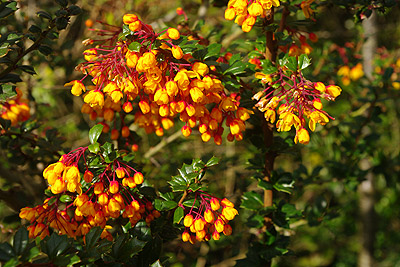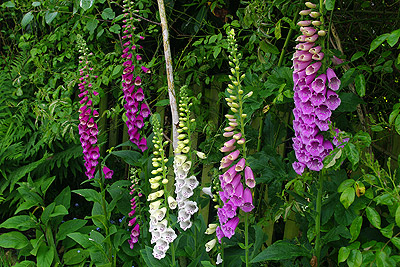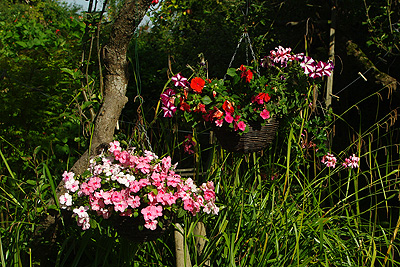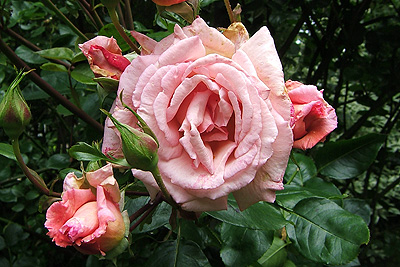The Garden in June - Jobs and Tips
plants for June
Jobs / Tips
![]() You should be mowing the lawn regularly by now, little
and often is best, don't leave it more than a week at most.
If you have a cylinder mower, then twice a week is better.
I know it's a chore, but as the summer progresses and gets warmer,
so the grass growth slows down and it becomes easier.
You should be mowing the lawn regularly by now, little
and often is best, don't leave it more than a week at most.
If you have a cylinder mower, then twice a week is better.
I know it's a chore, but as the summer progresses and gets warmer,
so the grass growth slows down and it becomes easier.
![]() Trim quicker growing hedges such as laurel, privet
and Lonicera nitida. If you've a hedge that you want to
extend or repair gaps in, now is a good time to take cuttings
for more plants.
Trim quicker growing hedges such as laurel, privet
and Lonicera nitida. If you've a hedge that you want to
extend or repair gaps in, now is a good time to take cuttings
for more plants.
![]() Stake tall growing perennials such as Delphiniums
and Lupins if you've not done so already before they
flop. They will flop as the flower heads open, even if the
wind doesn't get them, when it rains the water will weigh down
the petals and over the flowering spike will go.
Stake tall growing perennials such as Delphiniums
and Lupins if you've not done so already before they
flop. They will flop as the flower heads open, even if the
wind doesn't get them, when it rains the water will weigh down
the petals and over the flowering spike will go.
![]() A good time to start taking softwood cuttings of shrubs.
There are very many that can be propagated this way and
as it's so easy, you can try with almost anything. Take a shoot
4-5 inches long and make a cut just below a leaf joint, remove
most of the leaves, and also remove any flower buds. I place
about 6 cuttings in a 50:50 compost:sand mix around a small
pot 3-4 inches in diameter which should then be placed somewhere
fairly humid and bright, but with no direct sunlight. A cold
frame is ideal as is under the staging in a greenhouse. Keep
moist and check for roots coming out of the bottom in a month
or so, pot up the small plants individually to grow them on.
A good time to start taking softwood cuttings of shrubs.
There are very many that can be propagated this way and
as it's so easy, you can try with almost anything. Take a shoot
4-5 inches long and make a cut just below a leaf joint, remove
most of the leaves, and also remove any flower buds. I place
about 6 cuttings in a 50:50 compost:sand mix around a small
pot 3-4 inches in diameter which should then be placed somewhere
fairly humid and bright, but with no direct sunlight. A cold
frame is ideal as is under the staging in a greenhouse. Keep
moist and check for roots coming out of the bottom in a month
or so, pot up the small plants individually to grow them on.
![]() Start watering containers regularly. If you don't
need to water them daily, but they should be checked daily as
a hot day, particularly if there's a drying wind, can suck all
of the water out of a container. If you're planting up any containers,
then go for the largest you can afford. Containers are very
popular particularly at this time of the year when filled with
the bright flowers of bedding plants, but you have to work at
it to keep them looking good, watering, feeding and dead-heading
regularly for the best show.
Start watering containers regularly. If you don't
need to water them daily, but they should be checked daily as
a hot day, particularly if there's a drying wind, can suck all
of the water out of a container. If you're planting up any containers,
then go for the largest you can afford. Containers are very
popular particularly at this time of the year when filled with
the bright flowers of bedding plants, but you have to work at
it to keep them looking good, watering, feeding and dead-heading
regularly for the best show.
![]() Feed container plants regularly too. Get a soluble
plant food and use it according to the instructions, little
and often is best, so have one day a week as your feeding day
where you do the rounds. Many container plants are very greedy
feeders, that's how they manage to produce so many wonderful
flowers for so long.
Feed container plants regularly too. Get a soluble
plant food and use it according to the instructions, little
and often is best, so have one day a week as your feeding day
where you do the rounds. Many container plants are very greedy
feeders, that's how they manage to produce so many wonderful
flowers for so long.
![]() Dead-head perennials and shrubs such as roses.
This keeps them producing more flowers rather than putting their
energies into seed and fruit production. A daily round of the
garden in the evening is ideal if you can manage it, or as often
as possible otherwise if not.
Dead-head perennials and shrubs such as roses.
This keeps them producing more flowers rather than putting their
energies into seed and fruit production. A daily round of the
garden in the evening is ideal if you can manage it, or as often
as possible otherwise if not.
![]() Water autumn and spring planted trees and shrubs during
hot dry spells. If you "baby" trees and shrubs through their
first summer, them they're usually fine from then on. Give them
an occasional thorough soaking though rather than a daily drizzle
as little and often teaches them to grow shallow superficial
roots rather than encouraging long deep roots that help them
fend for themselves. A bucketful each a week for trees in midsummer
if it doesn't rain.
Water autumn and spring planted trees and shrubs during
hot dry spells. If you "baby" trees and shrubs through their
first summer, them they're usually fine from then on. Give them
an occasional thorough soaking though rather than a daily drizzle
as little and often teaches them to grow shallow superficial
roots rather than encouraging long deep roots that help them
fend for themselves. A bucketful each a week for trees in midsummer
if it doesn't rain.
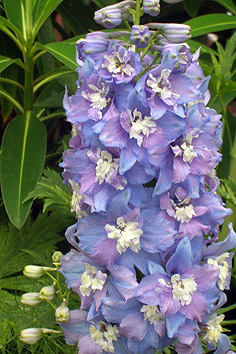
![]() Look for and remove "suckers" on roses or grafted
trees. These are shoots of the wild-type rootstock that
the ornamental foliage is grafted onto and will emerge below
the graft union which should be fairly obvious as a knobbly
irregular region at the bottom of the stem or trunk just above
the soil level. If left, then the rootstock being more vigorous
(hence its use as rootstock) will take over the ornamental part
of the plant.
Look for and remove "suckers" on roses or grafted
trees. These are shoots of the wild-type rootstock that
the ornamental foliage is grafted onto and will emerge below
the graft union which should be fairly obvious as a knobbly
irregular region at the bottom of the stem or trunk just above
the soil level. If left, then the rootstock being more vigorous
(hence its use as rootstock) will take over the ornamental part
of the plant.
![]() Look out for and remove plain green branches on variegated
shrubs and trees. Like suckers, they are more vigorous and
will take over the variegated part of the plant if left.
Look out for and remove plain green branches on variegated
shrubs and trees. Like suckers, they are more vigorous and
will take over the variegated part of the plant if left.
![]() Keep pruning spring flowering shrubs as they fade,
they can be pruned back to get a good display next year.
Keep pruning spring flowering shrubs as they fade,
they can be pruned back to get a good display next year.
![]() Keep watching out for aphids and other pests.
anti aphid
Keep watching out for aphids and other pests.
anti aphid
![]() If you've an apple tree, then expect the "June drop"
this is where the tree rids itself of the excess fruits that
have set. Fruit set depends on the weather and pollinators at
flowering time and so is somewhat variable, the tree therefore
produces far too much and then thins it out itself as appropriate.
These fallen fruits make great ammunition for catapults, if
you've a brick wall handy, then chalk a target and fire away
- my sons and I have passed many a happy hour in this way. Alternatively
a stickt and a dog are another good way to use the fallen fruit,
use bat to hit fruit - dog chases fruit - much fun had by all.
If you've an apple tree, then expect the "June drop"
this is where the tree rids itself of the excess fruits that
have set. Fruit set depends on the weather and pollinators at
flowering time and so is somewhat variable, the tree therefore
produces far too much and then thins it out itself as appropriate.
These fallen fruits make great ammunition for catapults, if
you've a brick wall handy, then chalk a target and fire away
- my sons and I have passed many a happy hour in this way. Alternatively
a stickt and a dog are another good way to use the fallen fruit,
use bat to hit fruit - dog chases fruit - much fun had by all.
Copyright 2000 - present. All Rights Reserved | Privacy Policy Statement

